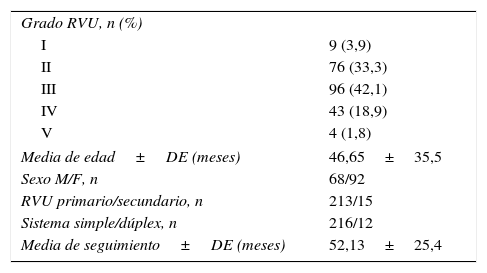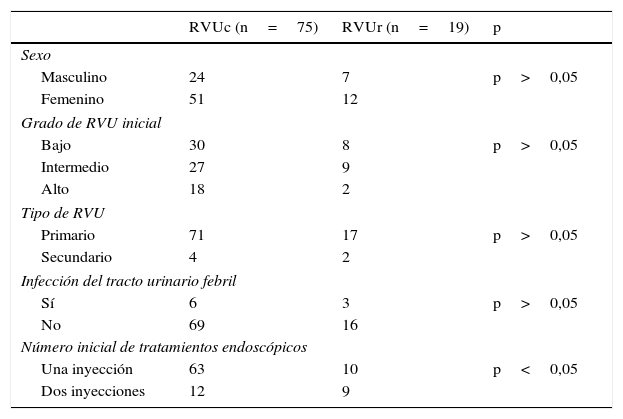La mayoría de las guías recomiendan realizar una cistografía miccional (CUMS) temprana tras el tratamiento endoscópico del reflujo vesicoureteral (RVU), pero no hay consenso sobre cómo hacer el seguimiento a largo plazo en este grupo de pacientes. El objetivo de este estudio es analizar si es necesaria la realización de una CUMS tardía en aquellos pacientes tratados con éxito.
Material y métodoHemos revisado las historias clínicas de aquellos pacientes tratados de RVU con el copolímero de dextranómero/ácido hialurónico (Dx/AH) desde 2006 a 2010. Se han seleccionado aquellos pacientes que estaban curados tras el tratamiento con más de 3 años de seguimiento y control cistográfico tardío. Hemos analizado los hallazgos clínicos y radiológicos a largo plazo.
ResultadosCiento sesenta niños con 228 uréteres refluyentes recibieron tratamiento con Dx/AH con un seguimiento medio de 52,13 meses. A 215 se les realizó CUMS de forma temprana, siendo la tasa de éxito del 84,1%. El grupo de estudio fueron 94/215 uréteres refluyentes que tuvieron un seguimiento clínico y cistográfico tardío mayor de 3 años. En el 79,8% la CUMS mostró ausencia de RVU, siendo la tasa de éxito tardío clínico del 91,7%. La incidencia de infección del tracto urinario febril entre aquellos que estaban curados desde el punto de vista radiológico frente a aquellos en los que recidivó el RVU fue del 8 y 15%, respectivamente. Solo existieron diferencias significativas en la recidiva del RVU entre aquellos uréteres que se habían tratado de forma inicial con una punción o con 2 punciones de Dx/AH.
ConclusiónSi el objetivo del tratamiento del RVU es disminuir las infecciones del tracto urinario febril, no es necesario realizar una CUMS tardía tras un tratamiento exitoso inicial con Dx/AH, a pesar de que la tasa de éxito radiológico es menor que la del clínico.
Some guidelines recommend an early voiding cystourethrography (VCUG) after endoscopic treatment of vesicoureteral reflux (VUR), but there's no consensus if it's necessary a long-term follow-up in these patients. The aim of our study is analyze if it's necessary a delayed VCUG after initial successful treatment with Dx/HA.
Material and methodWe have reviewed all medical charts of patients that underwent Dx/HA treatment from 2006 to 2010. We have selected patients with initial successful treatment and more than 3 years of radiological and clinical follow-up. We have analyzed late clinical and radiological outcomes.
ResultsOne hundred and sixty children with 228 refluxing ureters underwent Dx/HA endoscopic treatment with a mean follow-up of 52.13 months. Early VCUG was performed in 215 ureters with an initial successful rate of 84.1%. The group of study was 94/215 ureters with more than 3 years of follow-up with a delayed VCUG. VUR was still resolved in 79,8% of the ureters. Clinical success rate was 91.7%. The incidence of febrile urinary tract infection in those patients with cured VUR and those with a relapsed VUR was 8 and 15%, respectively; but there were no significant differences. We have not found any variable related with relapsed VUR except those ureters that initially received 2 injections (P<.05).
ConclusionIf our objective in the treatment of VUR is to reduce the incidence of febrile urinary tract infection it is not necessary to perform a delayed VCUG even though the long-term radiological outcomes is worse than clinical outcome
Artículo
Comprando el artículo el PDF del mismo podrá ser descargado
Precio 19,34 €
Comprar ahora













